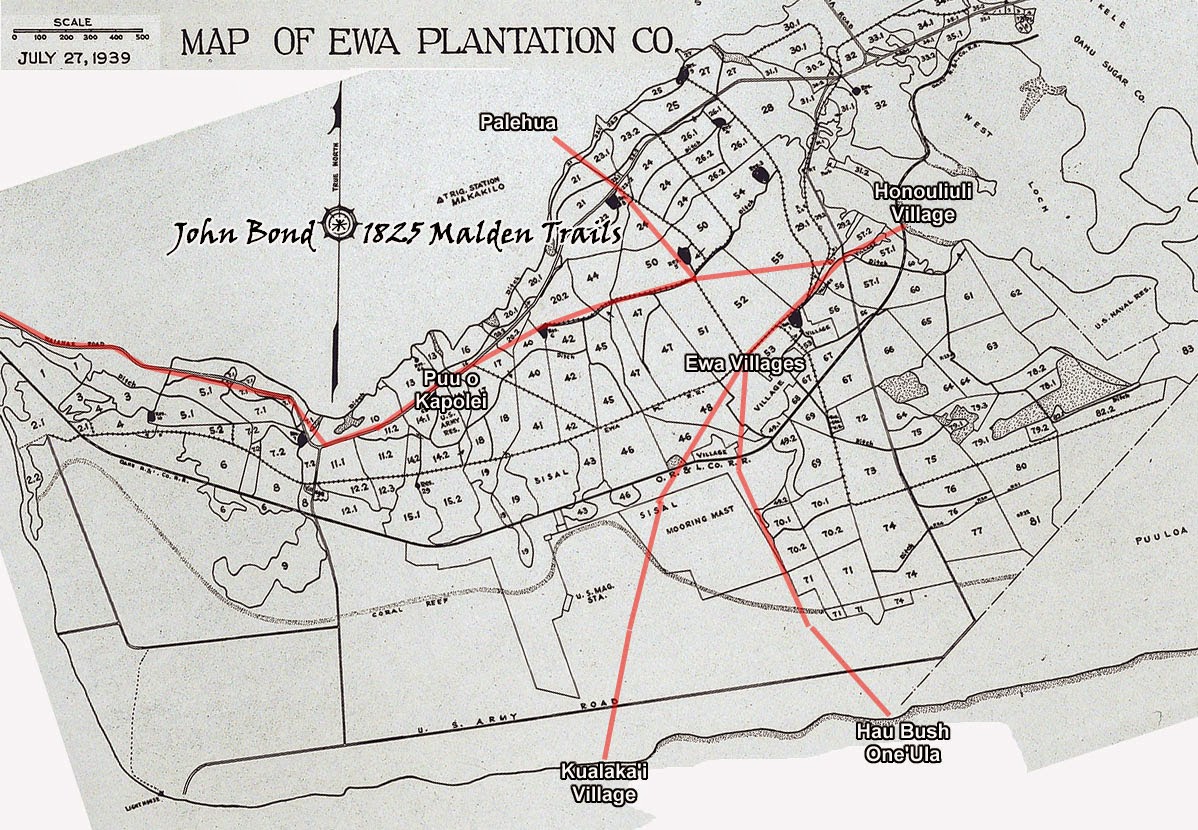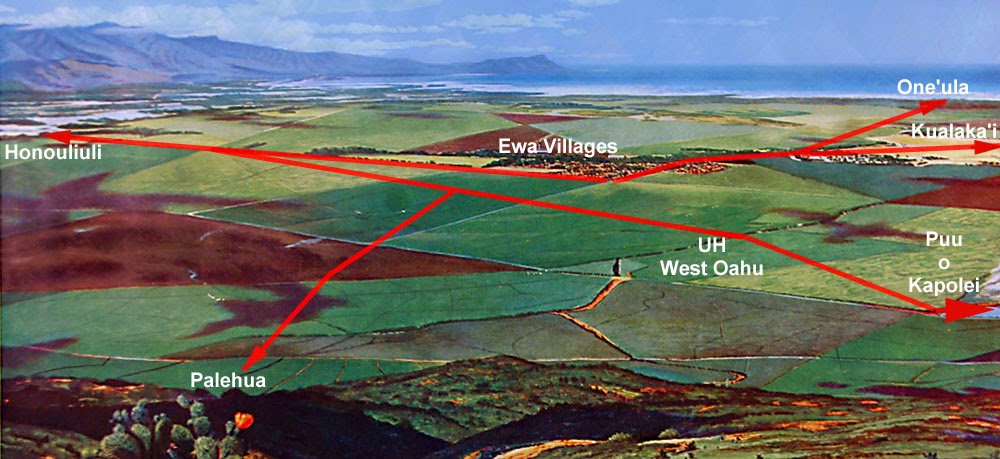A Five-Minute Look at Section 4(f) Law That HART Rail Is In Violation Of In Honouliuli Ewa Traditional Cultural Properties
A Five-Minute Look at HART
Section 4(f) Violations
When does Section 4(f) apply? 4(f) applies to all projects that receive funding from or require approval by an agency of the U.S. DOT, including FTA. Compared to the many environmental laws that apply to FTA actions, 4(f) is considered to have stringent approval standards by statute and court interpretation.
Area of Potential Effect (APE) of West Oahu Farrington Hwy Guideway (WOFH)
Stringent approval was NEVER done. Instead FTA and SHPD were under enormous political pressure to expedite review of extremely poorly done Archaeological Inventory Surveys to meet extremely early rail construction contracts in the WOFH Honouliuli ahupua'a. The entire goal was to rush construction so that HART could say "we can't be stopped now" and this will also be their mantra as the project racks up billions in cost overruns and years of delays.
What does Section 4(f) require? Before approving a project that "uses" a Section 4(f) resource, FTA must find that there is no prudent and feasible alternative AND that the selected alternative minimizes harm to the resource. If there is a prudent and feasible alternative that completely avoids 4(f) resources, it must be selected. If there is no prudent and feasible alternative that avoids 4(f) resources, FTA has some discretion in selecting the alternative that causes the least harm to 4(f) resources.
The 1825 Malden Map which clearly indicated a major native Hawaiian konohiki based civilization and political center at the time of Western contact. The largest population on Oahu lived here. 95 percent of the population was quickly wiped out by the introduction of Western diseases.
FTA and HART are NOT building a rail transportation as promised and sold to Oahu voters but instead using rail transit funds to pave over and destroy valuable farmland used for one-thousand year old continuous agriculture. HART is all about LAND DEVELOPMENT and offering it to foreign investors to profit with as they desire to the great detriment of the environment and cultural heritage of the Hawaiian natives and residents of the island of Oahu.
What is a Section 4(f) resource? 4(f) resources include any publicly owned public park, recreation area, or wildlife or waterfowl refuge or any publicly or privately owned historic site.
The 1825 Malden Trails overlaid on the Ewa Plantation fields map. The largest and most profitable sugar plantation in Hawaii because of the top grade volcanic soil and abundant springs under the karst reef.
The sites where FTA transit funds are being used to encourage complete and total NUKING of farmland used continuously for one thousand years by native Hawaiians, over 100 years by Ewa Plantation and currently by truck farmers is really a gross violation in the use of transit funds and "taking" of extremely valuable farmland that also serves as an emergency civil defense backup food source.
What is a "use"? In discussing 4(f), "use" may mean either a direct use or constructive use. A direct use occurs when land is permanently incorporated into a transportation facility or when there is a temporary occupancy of land that is adverse to a 4(f) resource. Constructive use occurs when a project's proximity impacts are so severe that the protected activities, features, or attributes that qualify a resource for protection under Section 4(f) are "substantially impaired".
HART Rail and FTA encouraging the complete destruction of highly valuable farmland used continuously for over 1000 years as a Traditional Cultural Property based on agriculture.
FTA transit funds are being used to build THREE rail transit stations on totally virgin open farmland that has been used continuously for one-thousand years. In addition the HART rail project is primarily a Land Development Scheme encouraging buildings, asphalt and concrete in a location where there never was an urban culture! In fact HART Rail doesn't even go to the main communities it was meant to serve (Kapolei and Ewa) and instead creates an ENTIRELY NEW sub CITY that will be called "East Kapolei" the local residents will have to commute to use the supposed local rail transit system.
What is feasible? An alternative is considered feasible if it can be constructed as a matter of sound engineering. Alternatives that are studied in a Draft Environmental Impact Statement or Environmental Assessment are almost always feasible; otherwise they should not be carried forward for detailed study.
Native Hawaiians are increasingly rediscovering their own culture that allowed them to maintain a highly successful and sustainable civilization for 1000 years. The Makahiki processions honored the god of agriculture- Lono. Today the god of Oahu is $$$ that all politicians worship.
What is prudent? The Supreme Court has defined an alternative as not prudent only if it involves "truly unusual factors" or "unique problems" or the cost of community disruption reaches "extraordinary magnitudes". FTA uses a number of factors, including the project context and the severity of impacts to non-4(f) resources, in determining what is prudent.
West Oahu's new RED LIGHT district - where asphalt and concrete rule over sustainable agriculture.
Numerous studies including even by FTA and their contracted engineering firm that specialized in rail projects predicted that HART's "numbers and estimates" for construction costs and completion times were UNREALISTIC and NOT LIKELY based upon all previous real world transit projects. Yet HART and City officials promised "On time and on budget" which clearly isn't happening. Among "community disruption" and "extraordinary magnitudes" is paying billions MORE for a project that was clearly a BIG LIE land development scheme from the very beginning.
Land developers want to dump excess toxic water runoff into Pearl Harbor directly and into "holding ponds," where on the ancient karst coral reef will drain the toxic water into the ocean anyway.
The Rail Fixed Guideway could have saved BILLIONS by using modern state-of-the art MagLev rail technology used worldwide which is nearly noiseless, requires far less maintenance and uses smaller pylon supports, however the City would NOT ALLOW MagLev as an alternative rail consideration. Heavy steel on steel elevated rail requires hugely more expensive eight foot in diameter support columns and vastly higher maintenance costs. No other city in the United States would allow itself to be conned into a $300 million a mile construction con job that is really just a land development scheme.
Real estate land speculation, greed and developer profits rule over sustainability and common sense. Oahu is in a remote Pacific location with an extremely short food supply that must be shipped in at ever increasing cost. Oahu is based upon a short term head in the sand Lemming Culture.
The HART Rail is also a highly corruption prone project that rewards city officials to continue to LIE, take large campaign donations, special gifts and rewards to push the project endlessly forward despite massive financial costs using a very regressive and ever increasing taxation system with ongoing theft of other City government services and programs.
What is least harm? FTA must consider many factors, not just acreage of a 4(f) resource used. Does the project shave an edge of a resource as opposed to cutting through the middle? Alter an historic building versus alter surrounding land? Take an unused portion or a highly used portion of a park? FTA must consider the net impacts of each alternative after mitigation measures have been taken into account. If two alternatives cause "substantially equal" harm to 4(f) resources, FTA may choose either one.
1000 year old top grade volcanic soil will be covered in asphalt and concrete forever. The Honouliuli Ewa area was once known as the "Golden Triangle" bread basket of the best native Hawaiian agricultural products and later as the most profitable sugar plantation- all a renewable annual resource which is now being completely killed off by FTA-HART funded land developers.
FTA transit funds are being used to encourage construction and development on top grade virgin open farmland soil that has been used continuously for one-thousand years with very high productivity. In addition the HART rail project is primarily a Land Development Scheme that removes a highly important emergency food supply, runs counter to the Hawaiian cultural practice of sustainability, encourages vast over building, asphalt and concrete in a location where there never was an urban culture.
A 1000 year old continuous traditional agricultural culture will be paved over forever destroying
it. Oahu has never seen a project of this scope destroying such a vast agricultural resource.
it. Oahu has never seen a project of this scope destroying such a vast agricultural resource.
The impervious surface will create massive rain and flood control issues that will pour toxic runoff into interior waterways and preservation habitats killing endangered birds and poisoning reef fish, edible limu (algae) and the entire aquatic food chain.
Does Section 106 of the National Historic Preservation Act duplicate 4(f)? There is overlap, but they are two different types of requirements enacted by Congress on the same day in 1966. 4(f) is a substantive standard, while Section 106 is essentially a consultative procedural requirement.
The only FTA-HART mitigation are Rail TOMBSTONES to remember the DEATH of
a 1000 year old Honouliuli Ewa traditional sustainable Konohiki based agriculture.
FTA HART is definitely NOT applying Section 4f to the West Oahu HART rail project segment.
Who makes the 4(f) decision for (HART) rail projects? FTA decides whether Section 4(f) applies to a resource, reviews assessments of each alternative's impacts to 4(f) properties, and determines whether the law allows the selection of a particular alternative after consulting with the Department of Interior.
The FTA-HART Area of Potential Effect (APE) includes a major portion of Honouliuli Ewa's top grade Golden Triangle farm land. FTA chose to see NO EFFECT on any historic or cultural properties despite large amounts of TCP evidence and public comments.
This is a massive act of corruption in itself for a federal agency under major political pressure at high levels to make very rushed decisions on what is or IS NOT an important historic Traditional Cultural Place or Property in order to meet very rushed construction timelines.
A Plan To Restore The 1825 Malden Mapped Ancient Hawaiian Trails On The Ewa Plain
CIA Helps Establish Honouliuli Ewa As A Traditional Cultural Property - Place
Honouliuli Ewa was once ruled by a the agricultural god Lono connected by a major trail network.

































